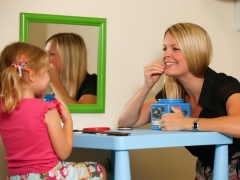How to teach a child to pronounce the sound "L" at home
Preschool age is the period of the most active development of the child. In his body, there are significant physiological changes, the development of thought processes, psyche, emotional and volitional sphere and the personality as a whole.
Studies have shown that all mental processes in a child develop with the direct participation of speech. And, obviously, the violation of this human function leads to difficulties in the harmonious development of the baby. In order to help the child in time to master the speech, parents should know the patterns of speech development of the child of preschool age.
Age deviations of speech development
Normally, by the age of three, the baby should have almost all the sounds of the language, with the exception of hissing (Ш,,,,)) and the sound of Р, Рь. This age is characterized by increased speech activity; children begin to use speech in order to learn new facts for themselves. In a different way, this is the age of the “why”.
Here are the common mistakes that children make at this stage of speech development:
- replacement of sound P to L, L (hand - hatch),
- replacement of sizzling W, U, H, F with soft Сь, Зь (scarf - syarf),
- replacement of L with sounds of L, Y (bow - hatch, lamp - yampa).
A five-year-old child should already correctly pronounce all the sounds of speech and use not only simple but also complex sentences to express his thoughts.
If a child misinterprets sounds for a long time, his motor articulation skills become fixed, and the perception of speech sounds is distorted. The baby does not sound correctly, but does not understand it. If the child is not helped in time, then a persistent speech defect will appear, which will be much more difficult to overcome.

Formation of the correct pronunciation of sounds in a child
Often, if a child does not have chronic diseases, abnormalities of the speech apparatus (tongue, soft and hard palate, lips), disorders of the nervous system, adults at home can help your baby master this or that sound. In this case, you only need to know the order of actions necessary to produce the missing or distorted sound.
- First, the most important thing for parents to start is to strengthen articulation motility. This is achieved through various exercises, which literature provides a lot.
- Secondly, it is the statement itself or clarification of sound. Each sound has its own method.
- The next step is to fix the sound first in syllables, then in words.
- After the child successfully utters a sound in words, he is offered tasks to differentiate (distinguish) oppositional sounds. (ZH-Ш, Ч-Щ, З-С, ТD, etc.).
- Next is the stage of memorizing pies, tongue twisters, riddles, poems with a set sound.
- And finally, we fix the sound in speech: storytelling, storytelling.
How to teach a child to pronounce a solid sound "L" at home
In this article we want to dwell in more detail on the formulation of solid sound "L".
Most often when pronouncing the sound “L” there are the following disadvantages: there is no sound at all, it is replaced by others - L, V, U, I. (the shop is “gable”, “return”). Due to the fact that pronouncing this sound requires the upper position of the tongue, you need to know if the child can lift it up.
In order for the tongue to clearly hold the desired position, we offer the following exercises designed to strengthen the muscles of the tongue:
- "Sting" - show the narrow language
- "Sting" - "Shoulder" - to show that narrow, then wide language.
- "Swing" - the tongue alternately touches the lower, then upper lip.
- "Pendulum" - the end of the tongue turns in the corners of the lips.
- "We will punish the naughty tongue" - stick out your tongue, pat it with your lips (five-five-five) so that it becomes wide.
- “The tongue sleeps” - slightly biting the end of the protruding tongue, opening and closing the mouth, lips and tongue relaxed and motionless.
After you notice that the child can easily cope with the proposed exercises, you can proceed directly to the formulation of the sound "L".
The first way to cause L: the spread tongue lies motionless between the teeth (“The tongue sleeps”), the mother suggests singing AAA and, without interrupting, bite the tip of the tongue while continuing to sing the same sound, it turned out ALL. I would like to warn you that at this stage it is not necessary to ask the child what kind of sound he has made. This can be done only after repeated repetition of the exercise, when he does everything.
The second method of setting: sing yyyy, while biting a wide tongue. This exercise is shown to the child in silence so that the sound of A cannot be heard, otherwise he will pronounce it with the usual distortion.
The sound received at the given receptions, is fixed at first in the closed syllables (AL, IL, OL, UL); further - between vowels (ALA, ILA, ULO ...), then in open syllables (LA-LA, LO-LO, LOU-LU, LA-LOU, LO-LU, etc.).
Further, as we said earlier, the sound is fixed in words:
- where the sound A stands at the end of the word: rear, donkey, chair, roll, glass, etc.
- where the sound of L stands at the beginning of the word: ski, bast, boat, puddle, horse, etc.
- where the sound of L stands in the middle of the word: canine, class, fame, eyes, flea, etc.
Then you begin to memorize simple poems, podeshki, riddles with the child in which the sound L is often encountered. This will automate the sound received and introduce it into speech.
Examples:
By the window glass
heavy drop of glass.
A drop has fallen on a blue flower
and opened one petal.
Run away, run away
milk ran away.
I hardly caught him,
Being a hostess is not easy!
All white, white, white.
A lot of snow piled up.
Here are fun days!
All on skis and skates!
If you are not confident in your abilities or are afraid in some way to harm the baby, then there is always a way out to go to specialized centers, which are now a great many. Having visited several speech therapy classes and having mastered the skill of pronouncing a “difficult” sound, your child will be fully able to continue working on developing speech with his parents.
We offer to do exercises with your child, shown in the next video of speech therapist Natalia Gorina.
How to prevent speech imperfections
Parents should remember that their behavior can also affect the development of the baby's speech. How should parents behave if they want their child’s speech to be formed without unnecessary complications?
- First of all, it is necessary to talk slowly and calmly with the baby. This is due to the fact that due to insufficiently developed auditory perception, the child will not have time to hear and recognize the speech of an adult.
- It is necessary to prompt the child how to pronounce the word correctly, which he is difficult to say. Usually kids are happy to repeat after adults. Just do not forget that excessive demands may offend the child, and he can completely withdraw.
- It is not advisable to overload the child with early learning of letters and reading, especially if this is done without his desire, since the expected result may be reversed.
- It is a mistake to force a young child to recite poems in front of guests. This is a great stress for a child whose speech is not yet fully formed. Subsequently such adult errors may cause stuttering.
- When late development of speech should not panic, you just need to pay more attention to speech games with the child in order to replenish his passive vocabulary.
- In addition, the normal functioning of other speech organs (hearing, voice, breathing apparatus, vision, smell, touch), whose well-coordinated work contributes to the formation of correct speech, helps to prevent speech development deficiencies.
Remember, speech development work does not end quickly. This is a long process. It is necessary to constantly expand the vocabulary of the baby, read books to him, make stories on the pictures, according to the impressions that he had. In every way encourage the child to communicate, gently and unobtrusively correct his mistakes, while giving him a sample of correct speech.
We bring to your attention the following video in which you can consider in detail the formulation of the sound "L" at home.
The production of the soft sound "L" is reviewed in the next video.






















